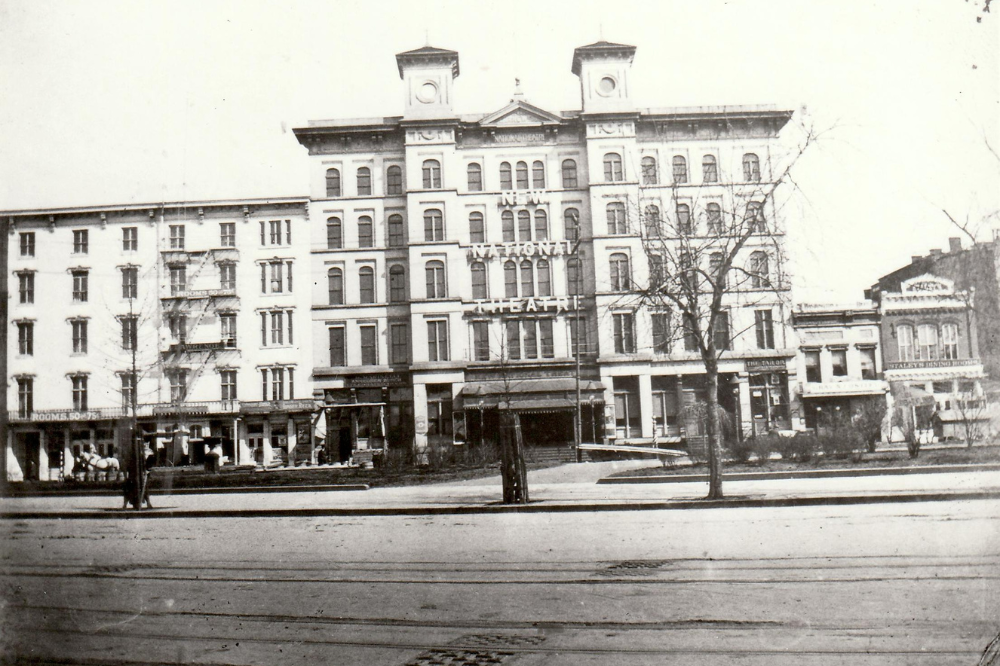Culture
 The exterior of “New National Theatre” circa 1900. Photo courtesy of venue.
The exterior of “New National Theatre” circa 1900. Photo courtesy of venue.
A Look Inside D.C.’s Iconic National Theatre
August 30, 2023 @ 3:00pm
Discover what makes The National Theatre one of D.C.’s most historic and iconic venues — and what to plan for when visiting this fall.
D.C. is home to a number of iconic theaters that are rife with history. But only one has been called the theater of the presidents: The National Theatre, the oldest theater in the city and second oldest in the country.
Almost every president since Andrew Jackson has attended performances at The National Theatre, which first opened in 1835. The National has historically been the cultural center for the performing arts in our nation’s capital, and is also the oldest enterprise on Pennsylvania Avenue continuously operating in its original designated capacity (Though it has survived or been rebuilt after several accidental fires over the years — the building we see today was built in 1920).
With nearly 200 years of history behind it, The National Theatre has an incredible archive of historic and culturally significant materials from past shows and events, including photographs, playbills, posters, letters, news articles and more.
“It tells a story of touring theatre in the U.S., spotted with extraordinary artistic experiences,” Executive Director David Kitto says. “Especially in the last century from 1900 forward, we were the most active venue in the city, up until probably the time the Kennedy Center opened.”
The list of highlights from the archive is extensive, featuring actors like Vivian Leigh and Laurence Olivier, and famous dance companies like the Ballet Russes; even Winston Churchill has spoken at the theater during a U.S. visit.
The National Theatre has been integral to the history of musical theatre and the birthplace for many classic American musicals. In fact, many Washingtonians may not know this includes the iconic West Side Story, which premiered at The National in 1957 on its way to Broadway (Chita Rivera, the very first actress to play Anita in the show, was also born in D.C.).
Now, the theater is taking stock of this archive and looking for ways to make it more available for consumption. Kitto says the theater is in the final stages of filing and digitizing all its ephemera. Once the digitization process is complete, the theater will make it available to the public, educators, researchers — anyone interested in digging into the rich history of U.S. theater.
“We want to learn how to use the archive to tell the story of who we are to the public and to the nation,” Kitto says. “There’s not another theater that has such an extensive legacy.”
As The National Theatre roots itself in the past, it is also making sure it stays relevant in its present and future. Contemporary musicals like “Mean Girls,” “If/Then” and “Beetlejuice” have enjoyed successful runs, and Kitto says the fall season is shaping up to be a popular one for the theater.
“The entire season is wonderful. I would pick out the pre-Broadway production of ‘The Wiz,’” which reiterates our position as a venue that houses pre-Broadway attractions.”
“The Wiz” will premiere in October; during the same month, The National will also show the new musical comedy “Mrs. Doubtfire,” based on the film of the same name.
The National also offers several community programs that give back to the neighborhood. Teens Behind the Scenes, targeted to high schoolers, provides tickets to performances for up to 65 local students who can attend a post-performance event with a dramaturg. The dramaturg interviews cast or production team members and invites students to participate in the discussion.
Saturday Morning Live, now more than 40 years old, is targeted to children ages 3-6 with their families, and is held on the second Saturday of every month.
“This is a very diverse program of content that’s beautifully appropriate for that age segment,” Kitto says.
Finally, Community Stage Connections offers performance experiences to underserved communities, as well as elder care facilities and Children’s National Hospital. This fall, the theater will also be introducing a new program called Afterwrds, a talk-back session for audiences following main stage performances.
Though entertainment has vastly changed since the theater’s founding, live performance remains an experience that can’t be replicated at home or on a phone. The National Theatre’s archive is a testament to that irreplaceable thrill of being in a room with live actors, experiencing a singular moment in time.
Not all of the theater’s history is contained within its own collection, however — sometimes surprises pop up, Kitto says.
“We discovered through a newspaper article that a man came forward with a letter from an actor in 1836, who stayed at a boarding house down the street and wrote about how beautiful the new theater was, and how excited all of the actors were to be performing in it.”
That enthusiasm can still be seen today in the exciting new shows and revivals of cherished favorites on The National Theatre’s historic stage.
The National Theatre’s fall season begins September 30. For showtimes and tickets, information on community programs and more, visit thenationaldc.com or call 202-628-6161. Follow on Instagram @broadwaynatdc.
The National Theatre: 1321 Pennsylvania Ave. NW, DC; thenationaldc.com // @broadwaynatdc







